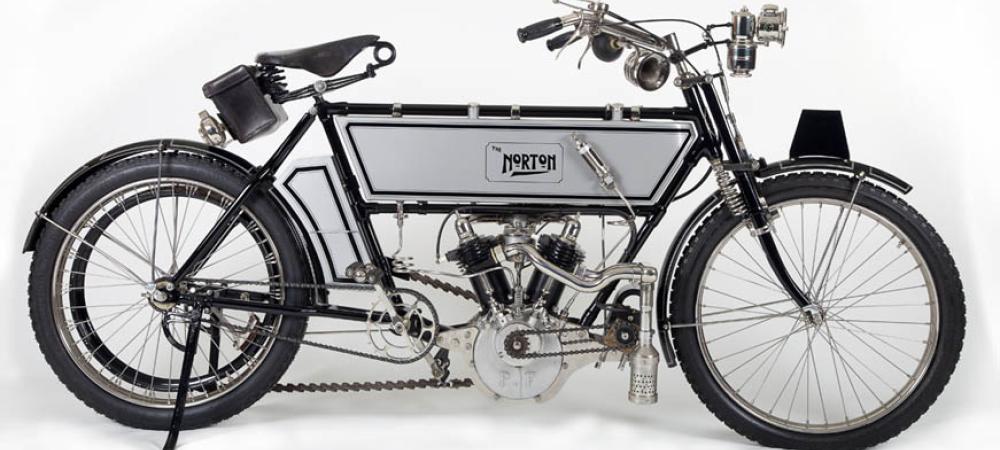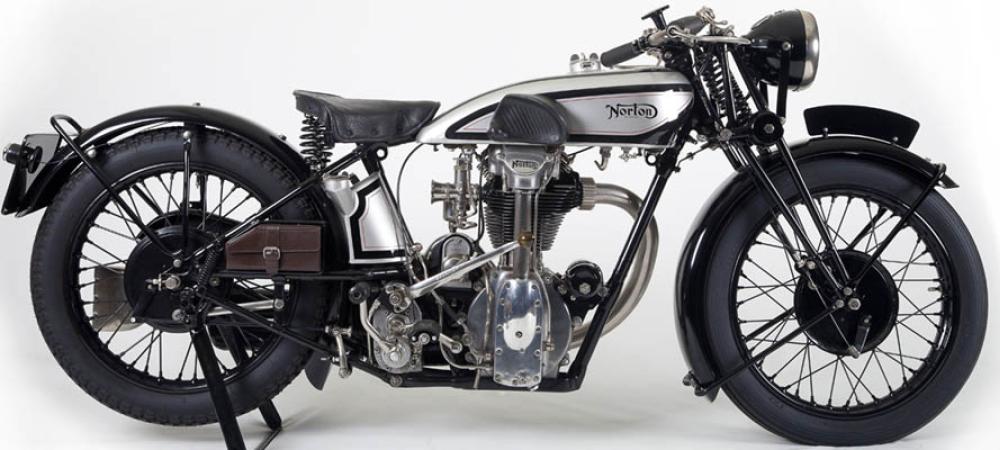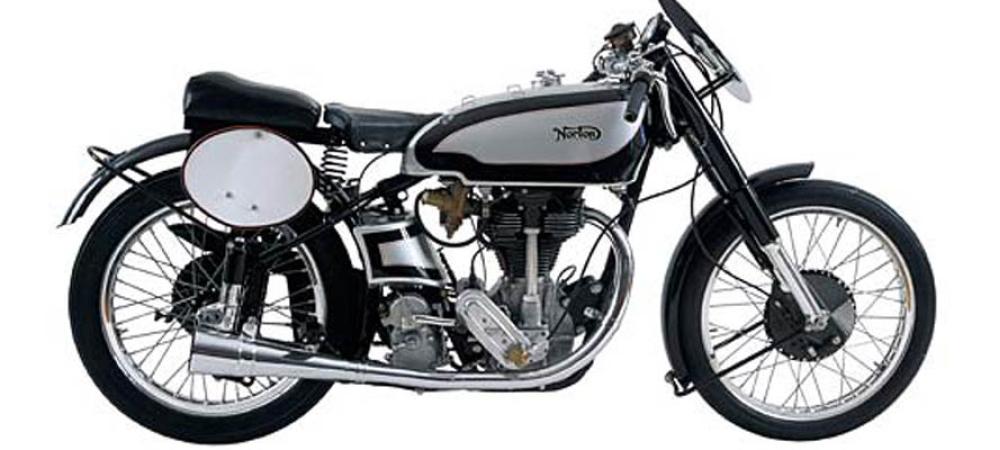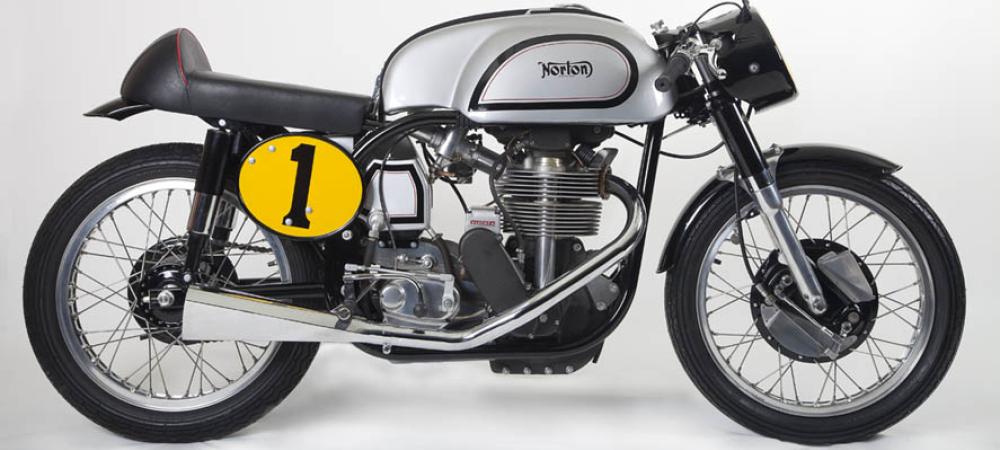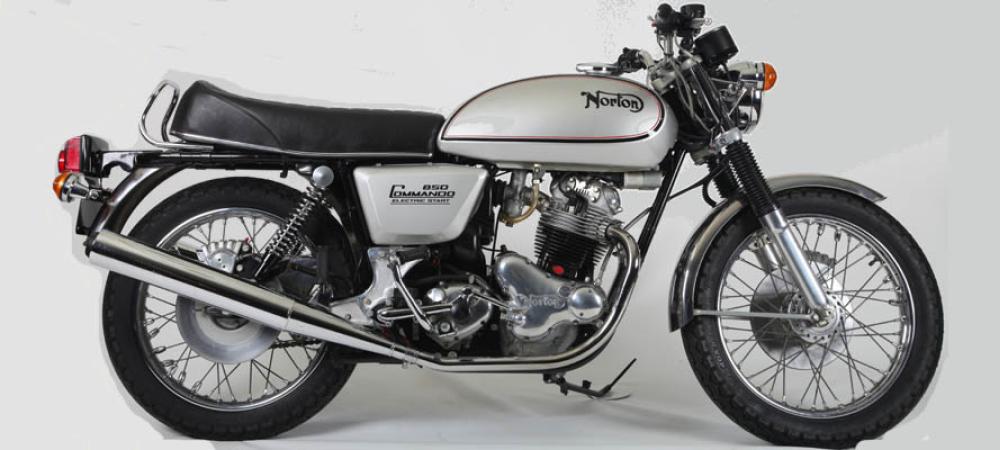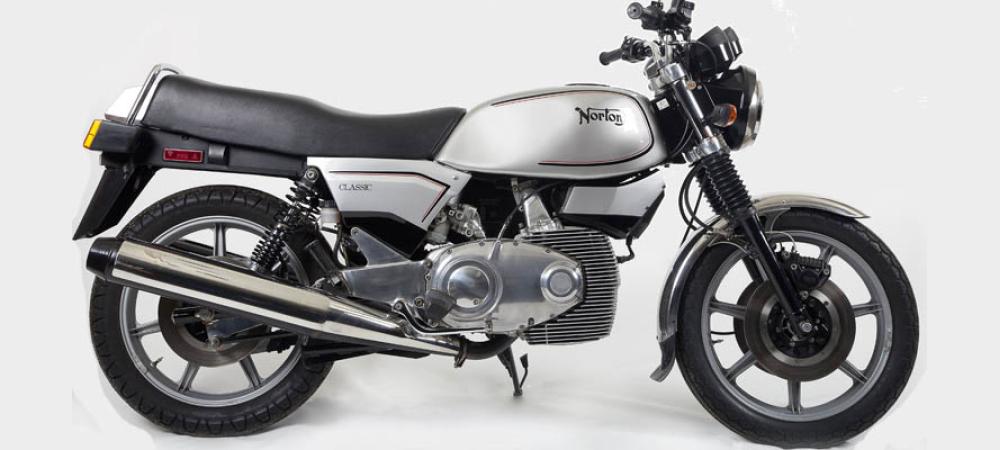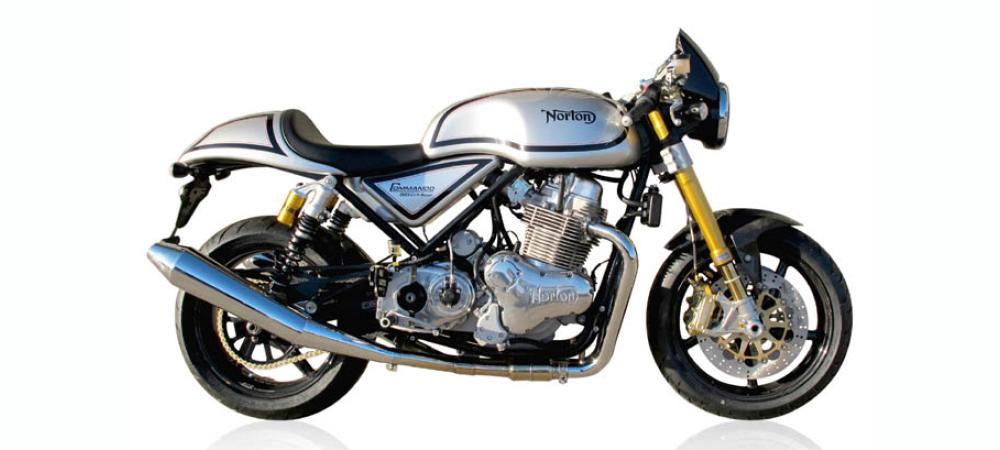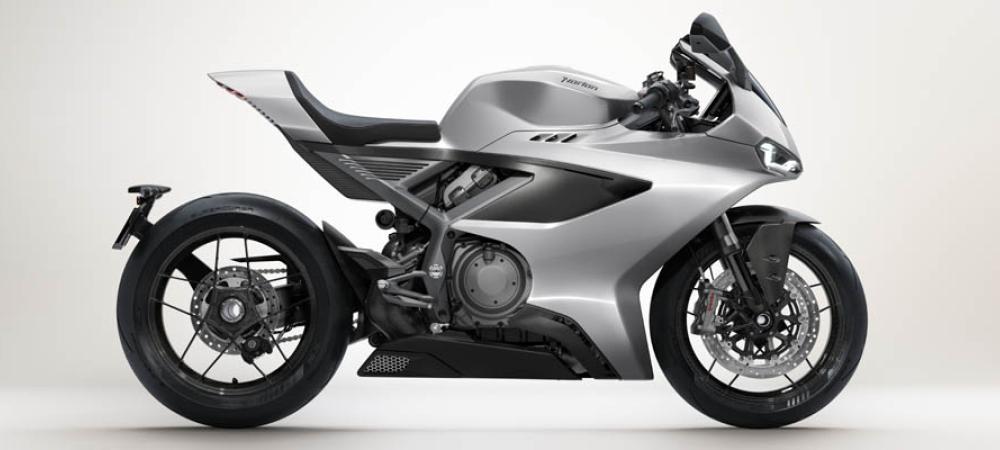A review of correspondence from NOC-L, Norton Notice and Brit-Iron
The Mk.lll Commando starter motor is not known for its reliability.
It can be modified to become a much more effective way of starting the machine
4-brush Prestolite conversion
Concerning the Mk.lll starter, the INOA Tech Digest says the following:-
A more reliable 4 brush starter can be constructed from your stock unit by installing the following Prestolite components:-
- Frame Field: #58-241, MGL 2101A - the body of the motor
- Brush Plate: #36-863, MGL 1033B - replaces the 2 brush set
- Spring Set: #50-335, MGB 18SS - springs to hold the brushes
Note that the conversion is not just a drop-in; the motor will run backwards or stall unless the new brushes are properly installed. Try spinning the motor with your car battery and jumper cables (note positive/negative ground differences) before installing; it should rotate counter-clockwise as viewed from the drive end.
A Prestolite starter with the improved 4 brush components is used in the Harley Sporster; if you are trying to save cash, used field assemblies can sometimes be had at the local H-D shop. Field assemblies and brush plates rarely fail, and can sometimes be gotten cheaply"
John Pinkham (pinkham@efn.org) on Brit-Iron 28th. Mar 1994
Prestolite parts commonly available from outboard motor breakers
Prestolite starters were used extensively in Mercury, Johnson and other similar U.S.A. type outboard motors. I have often obtained the necessary parts from outboard motor breakers yards or outboard motor repair shops.
Roy Armstrong (roy@mlb.dmt.csiro.au) on Brit-Iron 28th. Mar 1994
Detailed conversion instructions
Last year I tried to rebuild my starter using the instructions in Norton News #46. I found the article reasonably good but it assumed the person doing the modifications knew more about electric motors than I did. According to Walridge Motors, who sell the brush plate and the brushes as the 'upgrade kit' all you need to is attach the extra brushes to the existing field coil and your are done. I didn't go this route.
I bought additional field coils so that each brush works from its own coil assembly. The field coil is a dual loop winding through which that electricity passes and charges the armature. One end of the field coil is attached to the starter motor's assembly and the other has a brush attached to it and contacts the commutator. (This is the part of the armature that looks like parallel copper bars and is located in the end of the motor closest to the gear box). These are the positive charges.
The negative charge flows through the solenoid and attached to two brushes joined where the starter wire connects to the motor. There isn't much room in the end of the motor where the brush plate is located and it will only go together one way. There are metal dowels restricting how it goes together. I failed to get mine working as I had trouble setting the field coils.
There are several ways of attaching the open end of each winding to the housing. Originally they were welded or soldered to the housing. When I tried to do this, the solder wouldn't, and brass welds melted the coating in the windings. I repurchased the windings and plan something as simple as drilling a small hold for a very short securing screw. If you go with heat, you should try applying the heat to the outside of the field coil housing. This ensures it gets hot enough for solder to hold without melting the plastic housing.
There has been a lot of talk about being sure to wire the starter "like the Harley starter was wired" or it will run backwards. Since I don't know how the HD starter was wired, that bit of advice is useless. From what I can tell the brush poles are alternated + - + -. Since the brush wires only fit one way, I don't think you need to worry about this. If it doesn't work, you may need to change them to - + - + and that may require some splicing of the brush wires (I can't tell yet as I'm not that far). If it's assembled wrongly the starter motor will run backwards. I think it should run so that the armature turns clockwise. Be careful when you run the long bolts through the end cap to assemble the starter. If you don't do it carefully, you could strip the plastic casing from the field coil and short out the whole affair (this is experience speaking.)
A bigger battery (more amps) is important. You may be able to get away without replacing your battery tray by building a few plugs to level out the surface it sits on. You don't want your battery sitting on a ridge or it will break. If possible get a 750 battery tray. It's a lot of work to install this, but worth the effort as the battery sits nicely in it and the additional space is ideal for storing tool kit and spare cables. Finally, be prepared to replace the sprag clutch. If you use the electric starter for any period of time, it will eventually crush as it is a seriously weak link in the whole affair.
? (dancny@aol.com) on Brit-Iron 3rd. Aug 1995
Details of another conversion
An Electric Start That Works
Hey Mk.lll owners, if you're dissatisfied with the performance of your electric starter motor, maybe this article will help get your motor runnin' with the push of a button!
The first task is to make sure electrical system is in top-notch condition. This includes your battery, handlebar starter switch contacts, starter solenoid, starter leads and terminals. The next thing on the agenda is to acquire all the parts necessary to convert your Norton Prestolite starter from a two-brush to a four-brush motor. You will need:-
| Field Coil Windings |
Accel makes Prestolite starter field coils in two flavors for Harley Davidson Prestolite starter motors: stock replacement, and high torque (providing 20% more torque). |
| Brush Plate | You replace your two brush plate with a four brush plate |
| Brushes | You will need a new brush kit for the Harley Prestolite |
| Brush Springs | Of course, you will need four |
From your Norton starter you will use the end caps, the two long bolts and the armature. Check that the bushings and oil seal in the end caps are in good shape. If they are, proceed with assembly. When you fit the brushes in the brush plate, you will need to arrange so as to reverse their polarity. Move each brush one position clockwise from the 'Harley' position to reverse the phase. Hopefully the leads on the brushes are long enough- mine barely were. You will need to do some soldering when you fit the field coil windings to your case.
After you assemble the motor, you can check the rotation using a 12 volt battery, but make sure you ground the starter case to the positive battery terminal. The starter should rotate clockwise, as viewed from the drive end. If the rotation is correct, you are ready to install the motor. I only use my starter when the engine is warm, because of the rumors I've heard about the sprag clutch. So don't go raising your compression ratio and using the Accel high torque windings in your starter, and then come whining to me when you don't get trouble free service! Also, I am using a Lucas Rita electronic ignition, and my bike fires right up without cranking the starter motor excessively. I've heard the Boyer does not work as efficiently as the Rita when the starter is energized.
Jeff Gruwell, Norton Notice #215, Apr 1996
Starter motor maintenance
|
"I have a NOS starter motor for my Commando. The question I've got is this -- the workshop manual doesn't have details on lubrication for this motor. Has anyone done work on it and have a suggestion as to what lubricant to use on the rotor? The bearings look pretty tight (and sealed?)" |
Both ends of the Norton/Prestolite starter run in oilite bushes. As you may know, oilite is a fussy material, that is sintered from bronze, and saturated with oil. I say fussy, because it's so easy to 'smear' the surface, and destroy its self lubricating properties. However, if needed, new bushes are available from most shops that rebuild automotive alternators and starters ... similar Prestolite motors are used in a myriad of applications. If your bushes are new, but have been sitting around, I'd suggest re-lubing them as follows:-
- 1. Dismantle the motor and remove the seal from the drive end
- 2. Heat some SAE 10-40 motor oil to about 150 degrees Fahrenheit [65 degrees Celcius - Editor]
- 3. Drop the motor end covers, with bushes intact into the hot oil ... this will cause the oil to be absorbed into the oilite
- 4. Leave the bushes etc in the hot oil for an hour or so
- 5. Turn off the heat, BUT leave the bushes in the oil overnight ... i.e. let them cool down with the oil
When you're done, the oilite will be saturated with oil, and ready for service. Of course, this routine will work for nearly any oilite-bushed motor. If the bushes are worn, or the bearing surface is smeared, oil will not be absorbed, and replacement is your only (and fairly inexpensive) solution.
Greg Kricorissian (gkricor@ccs.carleton.ca) on Brit-Iron 18th. Apr 1997
The 4 brush/field conversion works
I have now run all summer without my kickstarter on my Mk.lll, with my modified starter which includes four field coils and four brushes and the sealed roller bearing in the drive end. Even on a cold damp day, the bike is running before I have had a chance to release the E-button. The battery is three years old as well and has done really well.
Jim Bush (jba@express.ca) on NOC-L 2nd. Sep 1997
4 brush/field conversion - how to do it
I know that Jim Bush has done an E-start mod. of his own as well, in which he replaced the drive end bush with a ball bearing. He remarked to me how much more starting 'punch' the E-start had after the ball bearing mod.; this makes sense if you consider the friction inherent in a bronze bush. I've heard advocates of increasing the gauge of the wires feeding the starter, but having since done so, I found that it provides no incremental benefit to speak of... the stock cables seem to be perfectly adequate for the 4 brush/field starter.
Recently, Ray Farrell inquired about converting the 2 brush Norton starter to the beefier 4 brush configuration. Having just completed the mod., I thought I'd post what you need to do.
- (1) You need to add an extra pair of field windings, 4 brushes, and a new brush plate. They are available as replacement parts, but the easiest thing to do is to buy a used Harley starter as a 'donor motor'. I don't recommend fitting new field windings to your old pole shoes, because it will be very difficult to dismantle them, and even worse to get them to sit straight when you reassemble. Also, the connections are spot welded together, so it's a loser all the way.
- (2) The next thing is to replace the two bushings in your motor. Usually the drive end one is OK, but the other (commutator) end is often all corroded and shot. Next, you MUST use the Norton armature, so clean up and polish its bearing journals. If it's not reclaimable, add a new armature to your shopping list.
- (3) So, now get yourself a donor starter! The first thing you need is the body (field windings and housing) from a Prestolite/Harley starter, and the proper brush plate. Quite likely, the back Norton rear cover will be shot due to corrosion, so you may as well get the Harley motor's rear cover as well. For some reason, all the Harley motors I saw didn't have rust in them ... draw your own conclusions. (the Harley armature is no use to you though, because the drive pinion is wrong). The subject starter motors were used on Harleys for years during the 1960s and 70s. The type number marked on the casing is a 'P-66A'. You'll notice it looks just like the Norton version, but there is a slight difference in its inside diameter at the drive end. Make up a thin shim bushing out of aluminum to take up the space between the i.d. of the body, and the drive end cover from the Norton motor. (This bushing will be very thin, but it is absolutely necessary to keep the armature from rubbing on the pole shoes). You'll see what I mean when you're in there!
- (4) Test assemble the motor using the Norton armature, modded Harley fields (with 4 brushes attached), and the Harley 4 brush-holder plate. Check the rotation with a battery. If you're lucky, the motor will be running clockwise as you look at the pinion. If not, dismantle the commutator end of the motor, and move the brushes from the holders they're in, to one holder clockwise, as you are looking at the brush plate. Reassemble and check again.
- (5) If all is well, now dismantle the motor, and seal the end covers with your favorite sealant to keep the weather out.
If the above sounds like Greek, or seems too complex to you, take the whole batch of stuff to an automotive shop that rebuilds alternators and starters. They are used to this stuff, and generally do good work for reasonable prices.
I also found the following:-
|
Prestolite starters were used on a number of outboard motors including, Mercury, Johnson, and other USA brands. A good source of spares is your local outboard motor workshop or wreckers |
Prestolite makes all sorts of motors for all sorts of applications. They mixed and matched armatures, field windings and mechanical bits to create numerous motors over the years which was not too unusual for a manufacturer wanting to re-use technology (albeit very low) to penetrate as many markets as it can. However, having gone through the Norton starter upgrade recently, I'd like to point out a few items:-
- (1) Harleys used Prestolite starters for many years, and used units are not hard to come by at Harley wreckers. While you're at it, also pick up a new set of armature shim washers, since the old ones will be rusty.
- (2) During the same period that they used Prestolites, Harley also used Hitachi starters. These are not the same beast at all, and nothing is interchangeable with the Prestolite unit.
- (3) I have seen Prestolites on outboards, but have been unsuccessful in finding any good used 4 brush/field units for sale ... they seem to last well in marine applications, and then they vanish from the face of the earth. One observation I made when checking availability is that the marine units I saw often had extra mounting brackets welded to the motor's housing, which makes re-use difficult.
- (4) Aftermarket field windings and brushes are available from Harley shops, at prices I found surprisingly reasonable (note: I didn't say 'cheap'; after all, it is for an HD). However, installing new fields in your motor will be difficult, since the motor's pole shoes will be invariably rusted in place, the screw heads will strip, and a couple of terminations are spot welded to the motor's housing. Worse, there isn't a lot of clearance between the pole shoes and the armature, so you'll find that one or more of the shoes will foul the armature when you re-assemble. These are not insurmountable problems, but it's a lot easier to find a good used housing/field assembly that's ready to use.
- (5) Note that you MUST re-use the Norton armature. The drive pinion is machined in one piece with the armature, and my experience indicates that it is unique to the Norton.
Greg Kricorissian (grkricor@ccs.carleton.ca) on NOC-L 5th. Sep 1997
4 brush/field conversion - how to do it (another version)
Here's my previous posting on Norton/Harley starters.
In my own experience, it is not practical to try and convert a Norton 2 coil housing to four coil. The main reason is that the winding connections are spot welded to the case and together in a completely different configuration than the Norton unit. You will spend the best part of a day trying to figure it all out. If you want 4 coil/4 brush setup, use a Harley housing, they are readily available and are cheap if used.
Ball Bearing Conversion
Being a Kiwi, I decided that I would modify a Norton armature and end mounting cap to take a sealed 6203 bearing and install this. It has a 17mm internal diameter which means that the armature needs to be skimmed down from 11/16" (0.06875") to the 17mm (0.6693"). This cleans up the worn armature bearing surface as well. The aluminum mounting cap was machined to take the 6203 bearing. Do this from the winding side - machine off the bronze bushing nozzle and go right through the middle of the end cap until you reach one of the pinion nodes. Don't go any further than that as you need the nodes to keep the bearing from moving outward.The bearing actually fits quite nicely into the cap, a little proud on the winding side, but still clear of the armature. The length of the skim cut on the armature needs to be measured so that the toothed gear lines up in the right place when installed. I think I only skimmed the armature to the length to suit the depth of the bearing. Tight tolerances are critical for mounting the bearing - an interference fit. The captive end bush was replaced with a standard 3/8" i.d. x 1/2" o.d. x 3/4" long stock oillite bush from the bearing supplier for $1.17c.
When I tested a stock Norton starter (with the 4 brush housing) I noticed that it didn't spin freely, but it was strong. After the ball bearing conversion it spins very fast with ease. I'm of the opinion that the bronze bush actually sucks power out of the unit due to friction. Anyway I installed my modified assembly in a 4 brush winding from a Harley starter I picked up at a swap meet for $25. Toss away the Harley armature and the end mounting cap and use the winding/housing (with 4 coils) and the 4 brush holder. I also got a new solenoid from a local parts supplier for $17.00 - it's from the new Ford trucks. The starter works so well that I have removed the kick starter from the bike altogether.
Jim Bush (jba@express.ca) on NOC-L 6th. Sep 1997
A problem with the armature detatched from the shaft
My Commando Mk.lll starter motor, which has always worked well, recently started to run free without turning the engine. I assumed it was the sprag clutch and started to strip down the primary side. However I soon realised the problem was in the motor itself. The motor was spinning but the gear on the end of the motor wasn't. I looked in the book and saw that the gear is an integral part of the armature.
I took the motor apart expecting to find a broken shaft, but found that the gear is part of a short shaft (about 1" long) that includes the bearing surface. This shaft fits over the plain shaft on the end of the armature. There is no key, pin or spline to stop the two items rotating relative to one another, but they obviously weren't when the motor was operating correctly. Maybe they were supposed to be an interference fit. I showed the parts to an engineer where I work and he thought not. There is approx a 1-3 thou clearance now; if this had been created from an interference fit by the parts grinding away at each other there should have been considerable scoring, but the surfaces were in good condition.
I can only conclude the parts were attached using adhesive and there was some residue that might suggest this. On the engineers advice I am going to try Loctite 601, but I am not too hopeful. Has anyone had any experience of this problem? I have asked a Norton specialist but he said the gear was fixed as part of the armature and had never heard of one separating.
Mark Chambers (mark@mech73.freeserve.co.uk) on NOC-L 8th. Feb 1998
Update from Mark Chambers - January 1999
I had several replies from the list and concluded that my starter was non standard, being made up from two others. Anyway, I did glue the two parts back together using Loctite 601 and its still working fine. As it is fairly quick and simple to remove and dismantle the starter, if it fails again I will simply re-attach it using the same method.
Loose armature due to a poor conversion?
I have done quite a few starter mods. for the Norton and I would has-it-a-guess that your armature is from the Harley starter that has been turned down and had the gear itself re-mounted onto the armature (with adhesive ???).
I had tried a similar modification of removing the Harley gear and reattaching the Norton gear, however I had set up a spigoted pin joint. I gave this one away, when it was proving difficult to get it all centralised - and also a spare Norton armature turned up anyway. I would abandon your armature and source a good used or new armature and use that. The gear itself is an integral part of the armature, not 'stuck' on. If you have access to a machinist, look at installing a 6203 sealed ball bearing on the drive end instead of the bronze bush and seal. I have done this on several starters now and they work real good; the Harley starter gave me the idea. The drive end mounting plate and the armature will have to be machined to suit - it really is quite simple.
Jim Bush (jba@express.ca) on NOC-L 9th. Feb 1997
Loose armature - another Loctite fix
Like Jim Bush, I too have modded a number of the Norton starters, and find your situation puzzling. Early on, I checked with a motor shop about rewinding a shorted armature I had. The chap told me that the job is quite easily done: they press the existing shaft out of the armature windings, and press it into a new one, which is the same for all Prestolite starters. Thus, it would appear that this bears out what your parts book shows.
Perhaps your armature was indeed made in two pieces; but unless the engagement between the parts was rather long, it would be difficult to keep them aligned ... the outer bearing is overhung quite a ways from the armature. If you want to try the Loctite route (and you have little to lose), I would suggest you try Loctite RC 680 retaining compound. It has much higher strength than simple 601. The other alternative is Loctite Quick Metal, if you have enough clearance between the parts.
Greg Kricorissian (grkricor@ccs.carleton.ca) on NOC-L 10th. Feb 1997

